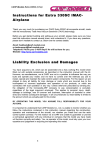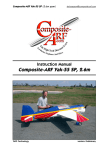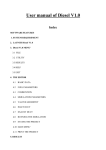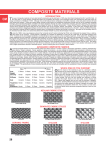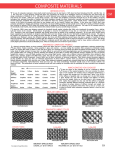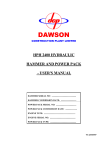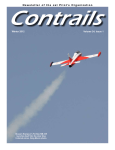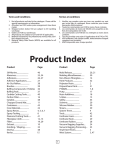Download Avanti T-18 Instruction manual
Transcript
XXL INSTRUCTIONS MANUAL Spesifications Avanti S Type : T.A.V.S Airex Carbon Composite Length : 112” (2860mm) Span : 97.6” (2480mm) Weight : 38—44Lbs ( 18—20 Kg) Engine : 40—45 Lbs (18—21 Kg) trust Avanti S XXL Thank you very much for purchasing our Avanti S XXL. Please note that the photos in this instruction manual show certain views from the prototypes. Some modifications and upgrades might have taken place by the release of the model. This manual describes the assembling of “ PRO” model. Before you start building and setting-up your aircraft, please make sure you have read this instruction manual, and understood it. If you have any questions, please don’t hesitate to contact us. SEBART © 2014 Assembly & Operation Manual Index: INTRODUCTION....................................................................................................................................... 3 DISCLAIMER..............................................................................................................................................3 WARNING…...............................................................................................................................................3 ARF PAINT.................................................................................................................................................4 FINISHING YOUR AVANTI ARF................................................................................................................4 HANDLING & TRANSPORTING ...............................................................................................................5 TOOL LIST................................................................................................................................................ 6 HEALTH…..................................................................................................................................................7 GENERAL ASSEMBLY TECHNIQUES..................................................................................................…7 RADIO EQUIPMENT & ACCESSORIES…………….................................................................................8 KIT CONTENTS…….……………...............................................................................................................9 OPTIONAL PARTS………………..……………….....................................................................................10 CONTROL LINKAGES ............................................................................................................................12 WINGS......................................................................................................................................................12 STABILIZERS...........................................................................................................................................15 FIN & RUDDER....................................................................................................................................... 16 FUSELAGE REAR & TAILPIPE…………………………………………………………..…………………….17 FRONT FUSELAGE……………………………………………………………………………………………...18 FUEL CELLS…………………………………………………………………………………………………...…18 FUEL DIAGRAM………………………….………………………………………………………………………19 AIR SYSTEM .......................................................................................................................................... 20 AIR DIAGRAM......................................................................................................................................... 21 TURBINE INSTALLATION……………………………………………………………………………………....22 COCKPIT & CANOPY…......................................................................................................................... 23 EQUIPMENT INSTALLATION ……………………………..………............................................................24 BEFORE YOU FLY.................................................................................................................................. 25 P-2 Assembly & Operation Manual INTRODUCTION Thank you for purchasing Sebart Avanti S. We have put a lot of effort and time into this model. We at Skymaster strive to be a market leader in the ARF— jet market. We were the first company to produce ARF—jets in the world and we would like to continue being amongst the best. Although we have made every effort that this model was fit for shipping, we would like you to inspect the contends and call your nearest dealer immediately if any defects or missing parts are spotted! This manual will allow you to duplicate the factory prototypes. LIABILITY You have acquired a kit, which can be assembled into a fully working R/C model when fitted out with suitable accessories, as described in the instruction manual with the kit. However, as manufacturers, we at Skymaster are not in a position to influence the way you build and operate your model, and we have no control over the methods you use to install, operate and maintain the radio control system components. For this reason we are obliged to deny all liability for loss, damage or costs which are incurred due to the incompetent or incorrect application and operation of our products, or which are connected with such operation in any way. Unless otherwise prescribed by binding law, the obligation of the Skymaster company to pay compensation is excluded, regardless of the legal argument employed. This applies to personal injury, death, damage to buildings, loss of turnover and business, interruption of business or other direct and indirect consequent damages. In all circumstances our total liability is limited to the amount which you actually paid for this model. BY OPERATING THIS MODEL YOU ASSUME FULL RESPONSIBILITY FOR YOUR ACTIONS. It is important to understand that Skymaster, is unable to monitor whether you follow the instructions contained in this instruction manual regarding the construction, operation and maintenance of the aircraft, nor whether you install and use the radio control system correctly. For this reason we at Skymaster are unable to guarantee, or provide, a contractual agreement with any individual or company that the model you have made will function correctly and safely. You, as operator of the model, must rely upon your own expertise and judgment in acquiring and operating this model. WARNING This ‘jet’ aircraft is a high-end product and can create an enormous risk for both pilot and spectators, if not handled with care, and used according to the instructions. Make sure that you operate your jet according to the AMA rules, or those laws and regulations governing model flying in the country of use. The engine, landing gear, servos, linkages and control surfaces have to be attached properly. Please use only the recommended servos and accessories. Make sure that the ‘Centre of Gravity’ is located in the recommended place. Use the nose heavy end of the CG range for your first flights. A tail heavy plane can be an enormous danger for you and all spectators. Fix any weights, and heavy items like batteries, very securely into the plane. Make sure that the plane is secured properly when you start the engine. Have a helper hold your plane from the nose before you start the engine. Make sure that all spectators are far behind, or far in front, of the aircraft when running up the engine. Make sure that you range check your R/C system thoroughly before the 1st flight. It is absolutely necessary to range check your complete R/C installation first WITHOUT the engine running. By pressing the range test button on the TX check the distance you can walk before ‘fail-safe’ occurs. Then start the engine, run at about half throttle and repeat this range check. Make sure that there is no range reduction before ‘fail-safe’ occurs. If the range with engine running is less then with the engine off, please DON’T FLY at that time. Make sure that your wing spar tube is not damaged. Check that the anti-rotation dowels for the wings are not loose. Check that the wing, stab, fin and nose retaining bolts are tight. Please don’t ignore our warnings, or those provided by other manufacturers. They refer to things and processes which, if ignored, could result in permanent damage or fatal injury. Secure the plane before starting engine. P-3 Assembly & Operation Manual ARF Paint The color finish on your Avanti S arf pro model was applied out of the mould. We have used only the highest standard automotive paints to finish your model. Should you damage the finish, Skymaster stock the color paint and hardener required for the repair. A good automotive spray painter should also be able to mix and supply the correct samples for repair. If you have no experience in the use of these paints, it will be best to seek assistance. Do not leave your model unprotected in the sun! always cover your model or park it in the shade. Extreme temperatures will damage the paint! Finishing Your All White AVANTI ARF PRO It is always best to fully assemble the model before painting. By doing so no damage or glue prints will ruin the paint. The all white model will have some release agent on the surfaces. Use #1000 wet and dry paper to sand the entire model. Mould lines can be sanded and filled using normal automotive fillers. The clear canopy is not installed. It is best to install these components after painting was done. P-4 Assembly & Operation Manual HANDLING & TRANSPORTING Composite models are very light but strong. These characteristics do have a down side! It is brittle. Take care when handling your model. DO NOT ATTEMPT TO PICK UP AN FULLY FUELED MODEL BY THE LEADING EDGE BY YOURSELF! The leading edges will crack and delaminate. Full size jets have specially marked access points for the hooks of cranes! Inspect your model before and after a rough landing. Make sure all parts are safe and sound. Inspect model before and after transport. A sudden stop can easily cause an unnoticed dent! The wings and tails are very flight worthy structures. They are light and extremely strong , however, they will dent if mishandled. Always support these structures on clean soft foam rubber. P-5 Tools and Adhesives Tools etc: Assembly & Operation Manual This is a fairly quick and easy plane to build, for a jet model, not requiring difficult techniques or special equipment, but even the building of Skymaster aircraft requires some suitable tools! You will probably have all these tools in your workshop anyway, but if not, they are available in all good hobby shops, or hardware stores like "Home Depot" or similar. 1. Sharp knife (X-Acto or similar) 2. Allen key set (metric) 2.5mm, 3mm & 5mm 3. Sharp scissors, curved type for canopy 4. Pliers (various types) 5. Wrenches (metric) 6. Slotted and Phillips screwdrivers (various sizes) 7. Drills of various sizes 8. Battery drill and Dremel tool (or similar) with cutting discs, sanding tools and mills 9. Sandpaper (various grits), and/or Permagrit sanding tools (high quality - recommended) 10. Carpet, bubble wrap or soft cloth to cover your work bench (most important !) 11. Car wax polish (clear) 12. Paper masking tape 13. Denaturised alcohol, Acetone, or similar (for cleaning joints before gluing) Adhesives: Not all types of glues are suited to working with composite parts. Here is a selection of what we normally use, and what we can truly recommend. Please don’t use inferior quality glues - you will end up with an inferior quality plane, that is not so strong or safe. Jet models require good gluing techniques, due to the higher flying speeds, and hence higher loads on many of the joints. We highly recommend that you use a slow cured epoxy for gluing highly stressed joints, like the hinges and control horns, into position and the most commonly used is ‘Aeropoxy’ (Bob Violett Models, USA). The self-mixing nozzles make it easy to apply exactly the required amount, in exactly the right place, and it will not run or flow onto places where you don’t want it! It takes about 1 - 2 hours to start to harden so it also gives plenty of time for accurate assembly. Finally it gives a superb bond on all fibreglass and wood surfaces. Of course there are many similar glues available, and you can use you favorite type. 1. CA glue ‘Thin’ and ‘Thick’ types. We recommend ZAP, as this is a very high quality. 2. ZAP-O or Plasti-ZAP, odourless (for gluing the clear canopy) 3. 30 minute epoxy (stressed joints must be glued with 30 min and NOT 5 min epoxy). 4. Aeropoxy/Loctite Hysol 3462 or equivalent (optional, but highly recommended) 5. Epoxy laminating resin (12 - 24 hr cure) with hardener. 6. Milled glass fibre, for adding to slow epoxy for stronger joints. 7. Micro-balloons, for adding to epoxy for lightweight filling. 8. Thread-locking compound (Loctite, or equivalent) At Skymaster we try our best to offer you a high quality kit, with outstanding value-for money, and as complete as possible. However, if you feel that some additional or different hardware should be included, please feel free to let us know. P-6 Assembly & Operation Manual HEALTH Use a mask (available at auto paint stores) to protect from inhaling the glass or carbon fiber dust. Use this mask whenever you are sanding or cutting fiberglass or carbon fiber materials. Use a charcoal filter paint mask (available at auto paint supply stores) when spraying any primer or paint. Spray out of doors or in a properly vented spray booth. Use safety glasses any time rotary tools, such as Dremel cut-off disc or Perma-Grit cutters, are being used. GENERAL ASSEMBLY TECHNIQUES We recommend to wax the model before assembling. This will help protect the finish from an epoxy finger print. Wax will not help for CA glues! Extra glue, extra paint, extra resin will add up to a heavy model. Plan before you glue! The glass cloth side of parts to glue, should be sanded with #80 grit paper for best glue adhesion. Support the fuselage on foam pads. Skymaster makes every attempt to insure that the parts fit. However, due to manufacturing tolerances, some parts may fit a little tight. Always trial fit parts and adjust if needed. Only use high quality adhesives such as the ZAP products from Pacer Technology. For extremely high stress areas we recommend “Aeropoxy.” It is the strongest and best gripping adhesive we have found. If fuel or grease are on the surface, first clean with acetone or thinners. Clean off all excess glue—excess glue is excess weight. Always check the outside skin of the model to look for any glue residue and remove it with Acetone before it cures. “Aeropoxy” is tough to remove once it has thoroughly cured. P-7 Assembly & Operation Manual Radio equipment Failure to use the recommended servos, output arms, extensions, and hardware may result in a loss of control! Throughout this manual we make use of various types of servos and radio equipment! We have used JR equipment during the installation process. If you make use of another manufacturer, please use equipment with similar specifications! The Avanti S will require extension leads! Please use high quality extension leads. Make use of ceramic non ferrite cores if leads exceeds 1 meter. The trend nowadays is to use dual battery management systems and dual RX equipment. With the introduction of 2.4 Ghz even quad RX systems are considered as normal for a jet model. Always center and install the correct output arms while on the bench, once the servo is in the aircraft access to the servo arm screw is sometimes limited. The JR Matchbox makes this task very easy. Some power boxes also include this servo matching function. Do not save any money when buying radio equipment. The price of servo’s are far from the price of replacing the entire model. REMEMBER: The best equipment is only as good as the weakest link. Ask yourself if this servo or link or lead etc is worthy of my trust to protect my very large investment... Accessories 1. 2. 3. 4. 5. 6. 7. 8. 9. 2 DS8911 servo’s for the elevator. 1 DS8911 for rudder. 2 DS8911 servo’s for ailerons 2 DS8911 servo’s for flaps 1 JR8911 steering servo. 3 Standard JR577servos for Landing Gear, Door and Wheel Brake valves or check next line. 1 Airpower EV5U valve Pneumatic support set for landing gear (air tubing, valves, Tee’s, fill valves, air tanks etc.) Turbine motor, with thrust range between 18kg and 20kg, with ECU, fuel pump, battery and solenoid valves, mounting strap etc. One of the common choices is the JetCat P180rx. 10. Fuel tubing, Hopper tank (or BVM UAT), festo fittings, fuel filters, fuel tube clamps etc. 11. Cable ties in various lengths. Cable management parts, Aluminum tape, safety clips etc. Did you understand everything in this manual completely? Then, and only then, let’s start assembling your Avanti S. If not, please read it again before you start the assembly. P-8 Kit Contents Assembly & Operation Manual Avanti S ARF PRO Contents: 1. 2. 3. 4. 5. 6. 7. 8. 9. Right wing including L/G + Doors installed. Include flap + aileron Left wing including L/G + Doors installed. Include flap + aileron Avanti wing fence L + R Fuselage front including nose gear + door installed. Including door cylinders installed + Hatch Fuselage rear Fin + Rudder Stabilizer L + R incl elevators) Aluminum main spar Cockpit P-9 Assembly & Operation Manual 3 x Air Tanks 1 x Retract Valve 2 x Filler & 2 x Pressure Gauges 1 x Electronic Brake Valve 5 x Air Tubing, 10 x Quick Disconnect 8 x T-pieces, 2 x 4 way Photo 1 Fuel Tank (1) 5,2L Smoke Tank (1) 2L Landing gear Photo 3 Photo 2 Airpower Optional 5 in 1 Electronic Valve & Sequencer or 2 way valves Control Brake, Gear and Doors Photo 4 Stainless Steel Tail Pipe Cockpit & Pilot Photo 5 Photo 6 P-10 Assembly & Operation Manual Pushrod set Photo 7 Oleo oil and pressure kit Photo 8 Tank Hardware Photo 9 Hardware Photo 10 P-11 Assembly & Operation Manual CONTROL LINKAGES Flaps : 80 mm (2) Aileron : 100 mm (2) Elevator : 100 mm (2) Rudder : 115 mm (1) Steering: 55 mm Photo 11 WINGS NOTE: Make sure to have some sort of protective foam on the work bench. This will protect the paint surface from unwanted dents. Assemble both wings simultaneously. Mark √ each step. Check operation of Landing gear and doors. Remove factory self tapping screws and replace with high quality screws. Inspect landing gear blocks. Make sure all parts are glued. Photo 12 Fit quick disconnects to air line and tidy pipes. Tighten all screws on wheels. Check the operation of brake Pull out the wire pin hinge. This will remove the flaps and ailerons. Remove and mark servo covers and inspect plywood. Use dremel to clean out some glue and ply to make sure servos will fit well. Photo 13 P-12 Assembly & Operation Manual Photo 14 Photo 15 Fit L-shape servo brackets to JR DS8911 Aileron servo must be mounted with horns facing outwards and must be furthest from control surface Secure servo horn and centre servo with TX. Secure extension wire. Use safety clips on joint. Fit servo to wing. Draw a line perpendicular to hinge line. Check ail down travel—horn must clear T/E wing. (p17) Use dremel tool to cut slot. NOTE—If no wood is located inside aileron, first glue wood into aileron before securing horn. Photo 16 Photo 17 Photo 18 Glue horn in place. Note—Use dual carbon horns through out with ball links. Fit pushrod. Mask servo cover and draw location of servo horn. Cut slots in servo cover. When happy with fit, secure servo cover. Refit wire hinge pin and check operation of aileron. P-13 Assembly & Operation Manual Secure servo horn to flap servo and set travel with TX. Mark location of servo horn on wing skin. Cut slot. Fit servo to ply mount with horn facing down. Photo 19 Draw line perpendicular to hinge line and mark location of flap pushrod. Secure pushrod to servo horn. Mark location for flap horn on leading edge of flap. (Note: Make sure flap can travel at least 45 degrees down and fully neutral. Dremel slots and glue with epoxy. Note—use dual carbon horns through out. NOTE—If no wood is located inside aileron, first glue wood into aileron before securing horn Photo 24 When cured check operation of flap. Cut hole for servo wires and secure with cable ties. Repeat for other wing. Photo 20 Trial fit wings to fuselage and mark location of hole for servo wires on fuselage. Cut hole in fuselage for servo wires. This complete this section. P-14 Assembly & Operation Manual STABILIZERS NOTE: Make sure to have some sort of protective foam on the work bench. This will protect the paint surface from unwanted dents. Mark √ each step. Photo 21 Photo 22 Fit servo horns and adjust travel and sub-trim with TX. Mark location of servo horn exit on bottom skin of stab. Cut slot for elevator horn. Bolt elevator servo to mount. Note—servo horn faces the tip of stab. It will not be possible to adjust horn without removing entire servo. Make up to identical elevator pushrods. Use bearing mount pushrods. Fit pushrods to servo horn. Draw a line perpendicular across hinge line and mark location of elevator horns. NOTE—If no wood is located inside aileron, first glue wood into aileron before securing horn Photo 23 Photo 24 Check travel of elevator and mark location of horns to clear stab T/E. Dremel slots for horns and glue with epoxy. Fit pushrod and check operation of elevator. Repeat for other elevator. P-15 Assembly & Operation Manual Make sure no slop and binding in system Run servo wires together in harness. NOTE : Make sure no wires can touch tailpipe. Touching tailpipe will melt wires and create short circuit. This will lead to crash. FIN & RUDDER NOTE: Make sure to have some sort of protective foam on the work bench. This will protect the paint surface from unwanted dents. Mark √ each step. Photo 25 Photo 26 Photo 27 Make pushrod. Double ball link. Fit horn to servo and set travel on TX. Mark location of servo horn on fin skin. Cut slot for horn in skin. Fit servo to mount. Fit the pushrod to horn. Mark location of rudder horn. Note travel of rudder to clear horn. Cut slot for 2 horns and epoxy. Fit pushrod. Secure extension lead. Run wire clear of pipe. When happy bolt fin to rear fuselage with 2 set screws. Check operation of rudder. Photo 28 P-16 Assembly & Operation Manual FUSELAGE REAR + TAILPIPE Make sure you have a good stand for fuselage. You will need to assemble the rest of the Avanti on this stand. Fuselage have a removable tail for easy transport. Photo 29 Install extension wires for 3 servos in the tail. Make sure wires do not touch the tailpipe. Use some ties to keep them clear of pipe. Make sure the connection is at location where the fuselage split. This for easy to remove tail for transport. Locate the 2 x M3 bolts and washers for securing stabs to fuselage. Fit stabs. Align carbon spars of fin into slots on fuselage. Tighten the M5 and M3 bolts to clamp fin in position. Fit belmouth to tailpipe with silicon adhesive. To make tail removable—you will need to make 2 mounts to hold tailpipe in position. (This may be already available on later models) Photo 30 This brackets must be removable. Mark locations of 4 L-brackets and drill 4 holes in tailpipe. Secure the brackets to tailpipe with stainless cap screws. Slide tailpipe into rear former. Exits about 1” (25mm) Photo 31 Bolt the front bracket to rear fuselage. Use 4 screws to secure L-Brackets to plywood support bracket. Not hight from top. Run servo wires to side for ease of connection to front fuselage. Photo 32 Photo 33 P-17 Assembly & Operation Manual FUSELAGE FRONT Fit the steering servo with m3 bolts. Make pushrod and secure. Check operation of steering. Photo 34 Fasten all screws on nose unit. Check operation of gear doors. Cut slots in engine mount to clear bel mouth. Photo 35 Trail fit rear of fuselage to front of fuselage. Photo 36 FUEL CELL Rinse the fuel tank and check for leaks. Make up fuel line clunk. Make sure clunk moves freely and reaches all corners of inside of tank. Fit to tank. Mark pipes for “inlet” and “outlet”. Photo 37 Install tank by silicon tank to tank mount. Plumb tanks using diagram on next page. Fill tanks and check for leaks. Drain tanks with fuel pump and check no air bubbles in system until last drop is drained. A good plumbing will secure good turbine operation. Photo 38 NOTE: A smoke tank is also available. It fits to the front of fuel tank. Separate plumbing is needed. Photo 39 P-18 Assembly & Operation Manual FUEL CELL DIAGRAM Photo 40 P-19 Assembly & Operation Manual AIR SYSTEM There are 2 options available for the air system: Mechanical or Electronic. For mechanical you will need 2 x 2 way and 1 x 1way valve with 3 servos and sequencer. For electronic you will need 1 x EV5U. Photo 41 The 1 large tank is for operation of gears and doors and the smaller tank for brakes. Fit the 2 filler valves and 2 pressure gauges onto accessory tray. Plumb the landing gear, door and brake system by using color air tubing. T all same color tubing together until a single pipe emerge. Fit electronic EV5U valve onto rear accessory tray. Route all 5 pipes to EV5U. The air system will consist of : Air up, Air down retracts (2) Air up, Air down doors (2) Air out brakes (1) Air in (2) Total of (7) pipes Air leaks can damage your model! Please do a thorough check for air leaks. Make sure the system can hold pressure for at least an hour in the up and down position. Do not rush this installation. P-20 Assembly & Operation Manual You can also use separate valves to control the L/G you will require two 2 way electronic valves and one 1 way valve. Photo 42 2 way AIR DIAGRAM Photo 43 Diagram for retracts P-21 Assembly & Operation Manual TURBINE INSTALLATION Photo 44 Please follow the instructions supplied with your turbine. Secure turbine to turbine rail via rear of fuselage. . Run all turbine wires and power cables on opposite side of servo wires. Always secure all wires in harness. I would suggest you install a FOD. This will save you money in the long run. Install fuel pump close to UAT. We recommend to make use of a mechanical shut off valve as well. Secure all Festo pipes with cable ties. Make sure fuel filter and gas canister are mounted vertical. Install Li Po or Li Fe battery in nose. I always put a fuse holder inline with power cable. No bypass is needed with bel mouth. Photo 46 Photo 45 Photo 47 P-22 Assembly & Operation Manual COCKPIT AND CANOPY (after painting) Trace the shape of canopy and cut to fit. Glue with canopy glue. (only for white ordered model) Trial fit cockpit and cut to fit. Glue cockpit to canopy frame with silicon. Or secure with bolts. Fit pilot. . . Photo 48 Photo 49 P-23 Assembly & Operation Manual EQUIPMENT INSTALLATION INTO Avanti S 1. 2. 3. 4. 5. 6. Equipment installation is a personal venture. There is one golden rule: Do it as neat and logical as possible! This will make fault finding and service of components easier. The Jet basically consist of 6 circuits! Servo wires Power cables Data cables Pneumatic pipes Fuel pipes RX cable / Satellite Receivers Please try and separate these circuits as far as possible. It is advisable not to run RX cables near any kind of electrical fields. Make all switches and filler valves and charging sockets easy accessible. The Avanti will come out tail heavy if you do not plan installation. It is very important to install all equipment as far forward as possible. I have installed 2 x RX + 1 X ECU batteries in front of nose gear. This is weight of 1 kg together. You will need 500g of lead in nose to correct CG I have installed a UAT in front of main tank. This will always be full of fuel and will help with the final adjustment of CG. The accessory trays are huge and easy accessible. This will make it very easy to install all accessories. . Photo 50 P-24 Assembly & Operation Manual BEFORE YOU FLY It is assumed that the builder of this kit has acquired the basic skills and knowledge necessary to make a safe and functional radio control installation into a model. Therefore, these notes are intended only to assist that experience. When inserting the main spar into wing, make sure it only enters the amount required. Please measure correct distance for main spar and secure spar so that it does not slide more to one side than other. It must be symmetrical to both sides. Travel adjust measured at root. Use Expo to suite your style. 1. Elevator 3. Aileron 5. Flaps landing 35mm 30mm 78mm 2. 4. Rudder Flaps take off 40mm 44mm NOTE : Make sure flaps travel same. Flaps should be deployed in landing circuit only below 90mph. CG 300mm from leading edge at root. Empty tanks, UAT full and wheels down. 330mm for 3D and expert pilots. The CG can be changed to best fit your flying style. A forward position is safe and nose heavy configuration. WARNING: Do not move CG back unless you are experience and have some feel of model before! Weight Dry weight will be between 38 and 44 lbs depending equipment. PSI 100—120 psi for pneumatic system Power Make use of battery management system. Double up on batteries and make sure all wired can carry current needed to operate. TX RX Do a complete range check before flight. Do this with turbine running. Follow manufacturers instructions. Speed Set the maximum speed to 180mph! The prototype were tested with Jetcat P-180 turbines. More powerful turbines require extra care and extra reinforcing. Timer A timer can safe your model. Get into the habit of programming the timer. P-25 Assembly & Operation Manual Take-Off Do some taxi tests before your flight! Make sure you are familiar with all settings and make sure the model track straight on the ground without rudder input. Choose a fine day for the maiden flight. Do not force a maiden flight! Select take off flap or flight mode 1 and open throttle. Gently pull back on stick 15m down the runway. Raise the flaps and gear at safe altitude and let the model sit on rails. Slow Flight Most of the first flight should be utilized to get familiar with the slow speed flight characteristics. Select the flaps to the takeoff position; there should be no pitch change. Extend the gear and select full landing flaps; adjust the power to maintain level flight and a speed of about 80—90mph. Landing Fly a complete circuit before landing. Approach from the downwind side and lower the LG. Fly a complete circuit getting use to the power required. On the next circuit lower the flaps. If you have a headwind be very careful not to get below the power curve on the downwind side. Because of the size of the model—it might not be flying the speed you thought it might be flying. Align the model and use throttle to control the descent! The elevators will stay very active even at low speed. Flare the model just before touch down. Let the model roll out and apply brakes. Nose high landings are easy with a very effective stab. Taxi back and do necessary adjustments to customize Avanti for your need! We at Skymaster and Sebart wish you many happy flights with your Avanti! Add some smoke and thrust vectoring and paint the sky! P-26


























